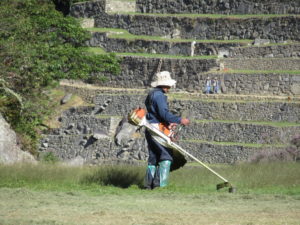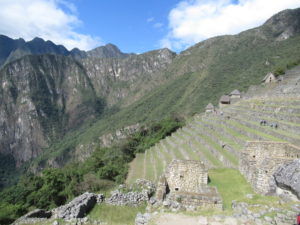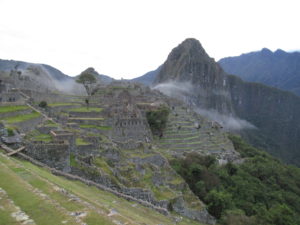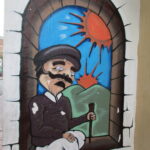In July 1911, a Yale professor named Hiram Bingham was led up a mountain ridge by local peasants living in the Cuzco region of Peru. The peasants called the mountain Machu Picchu, meaning “old peak.” The valiant Dr. Bingham, who is often cited as the inspiration for Indiana Jones, was looking for Vilcabamba, the lost city of the Incas. Vilcabamba was the Incas’ last refuge before the Spanish Conquistadors finally finished them off in the latter half of the 16th Century.
Upon reaching the top of the mountain, Bingham believed he had rediscovered that lost city.
In fact, it was Bingham himself who was a little lost.
Decades later, other researchers determined that Vilcabamba was actually situated a few hundred kilometers to the northwest of Machu Picchu, in Peru’s Amazonian jungle. Bingham had been there, but did not correctly identify the place. Instead he went to his death believing Machu Picchu was the elusive lost city.
But Machu Picchu, it seems, wasn’t so much lost as it was abandoned. No one actually knows how or why it lay uninhabited for some 300 years after the end of the Incas. For that matter, no one knows why the Incas built Machu Picchu in the first place, at the height of their power, or what the heck they did up there. Theories abound. Machu Picchu may have been a royal estate for the ruling class. It may have been a religious site. It may have been a prison, or a testing ground for new farming techniques and crops, or who knows what. The Incas were incredibly industrious and ambitious, at one point ruling 12 million people in a region covering 2,500 miles, while perfecting methods of construction, installing advanced irrigation systems, and creating a centralized economy. Yet their dynasty rose and fell in a span of less than 500 years.

This bridge surely went somewhere important at some point in time, but you’d have to ask an Incan ghost for directions.
Whatever it was the Incas used Machu Picchu for, Bingham’s “discovery” made the site world famous. People were astounded to see photos of, or witness in person, the gorgeous plateau nestled among higher mountains, upon which the Incas had built an astonishing array of terraces and pathways and buildings, all made of stones that were cut and laid so precisely that no mortar was required. So ingeniously crafted were the structures at Machu Picchu that even centuries of disuse and frequent earthquakes had barely disturbed a thing by the time Bingham came along.
Nowadays the historic site is under a different kind of stress. Over a million people visit each year. The Peruvian authorities now restrict the daily numbers, and there are rumors of further restrictions in the future, in order to preserve the pristine condition of this overwhelmingly popular destination.
So George and I figured it was high time we got our butts there.
Joined by our friends Paula and Karin, we made the trek on a tight schedule, keeping the whole trip within the confines of a single week. Getting to Machu Picchu is a bit complicated. It is truly an adventure of planes, trains, and automobiles. After a brief stay in Peru’s coastal capital – George and I had been to Lima before, while Paula and Karin were newbies – we took the short flight to Cuzco, which also took us from sea level to an elevation of over 11,000 feet. To avoid, or at least mitigate, the effects of high altitude, we hired a van to drive us immediately from the Cuzco airport to Ollantaytambo, a town two hours away and several thousand feet lower down, in what is known as the Sacred Valley, a region of the Peruvian Andes that was the foundation of the Inca empire.
From Ollantaytambo we boarded a 90-minute train to Aguas Calientes, a small tourist town at the base of Machu Picchu. The following morning, in the hours before dawn, we lined up with hundreds of other tourists to wait for the buses that would haul us up the hair-raising switchbacks of Bingham Highway to the entrance of Machu Picchu itself. We arrived at the gate just 20 days prior to the 106th anniversary of Dr. Bingham’s first visit.
The journey was well worth it. For years I’d been treated to other people’s pictures of Machu Picchu, always being told that as beautiful as the place looked on a postcard or phone screen, photos really couldn’t do it justice, that you absolutely had to see it for yourself. Add me to the list of people who will tell you that now. Machu Picchu is hard enough to describe in words, but it is almost impossible to explain the rush of feelings upon seeing it in person. As the sun rises behind the mountain mist you can imagine the awe the Incas felt too, standing in a place that seems like it should be inhabited by gods, not humans. Even the throng of other tourists doesn’t diminish the experience. In fact, Machu Picchu is large enough that you can find a quiet spot and feel almost all alone.
You can also hire a tour guide, though we didn’t bother and I’d say there’s no good reason to. The site is easy enough to navigate on your own. And from what I’d read online, many of the guides have a tendency to, uh, make shit up. The main reason no one knows what went on at Machu Picchu is because the Incas left no written record. This inconvenient truth did not stop one tour guide we overheard from telling his group that, atop a particular very large rock he was standing next to, the Incas sacrificed black llamas – only black ones, mind you – by carving their still-beating hearts right out of their torsos. It was at that rock that they did this, you see, and only that rock.
The Incas did indeed sacrifice animals, and people for that matter, in this most gruesome manner. But whether they did so at Machu Picchu is completely unknown. No human remains have ever been found there.
Another guide told his peeps about the Inca’s vast and prosperous middle class. Well, it’s true the Incas had a class society. And there were indeed decent-sized numbers of administrators and artisans who occupied a kind of middle ground between the royals and their priests at the top, and the laborers, farmers and slaves at the bottom. But those administrators and artisans worked long and hard every day, had almost no say in the affairs of their society, and generally did as they were told. They were by no means a middle class in the sense we use that term today.
We felt a little like the Incan slaves probably did – the ones who were forced to schlep enormous stones down one mountain and up another in order to build Machu Picchu – when we decided to climb Huayna Picchu, one of the two higher mountains that anchor the main site.
You have to buy tickets well in advance to climb Huayna Picchu, and they only let a few hundred people do the climb each day. But it wasn’t until we got started and realized how strenuous the 1,100 foot climb would be (the steps are cut into the stones at awkward depths and treacherous angles) that we decided we had to go all the way to the top or spend the rest of our lives knowing we wimped out. Fortunately all four of us made it. And even though the climb is potentially dangerous, none of us got hurt. (People have occasionally fallen to their deaths while climbing. We were pleased not to join them.)

A thousand feet below, you can see the main Machu Picchu site. To the left are the rollercoaster-worthy switchbacks of Bingham Highway.
After a long, exhausting, and utterly exhilarating day, our time at Machu Picchu came to a close. I’d say one solid day is enough to visit the site, though I can understand why some people choose to spend more time there. Some people even hike all the way there from Cuzco, along what is known as the Inca Trail. But whether you plan a longer journey through the region, or squeeze a visit to Machu Picchu into a single week as we did, it’s one of those magical places everyone should try to visit during their lifetime. It may not be the lost city Hiram Bingham was looking for, but it offers a unique glimpse back in time at some amazing accomplishments by a remarkable people at the most mysterious peak of their brief but extraordinary civilization.

Not everyone was as excited as us to be at Machu Picchu. Or maybe this dude had just finished climbing one of the mountains. He does look like we felt at that point.
























great pics!
OMG! I love your blog and pictures of this amazing place. I have to go, I tell myself. I love the fact that you gave us the historical significance to this magical place, and I felt as if I was in your history class, Dr. Singer. Love, love, love…
Love your description of the place and as always, your humor sprinkled throughout.
Great description Craig! I need to send you the pic of the sorry sleeping millennial to add to these pics. And don’t forget you were about to send a search party up the mountain to find my slow self. Love traveling with you and can’t wait for the Galapagos!!!
I added a pic of the sleeping guy! Thanks for the suggestion!
Awesome! Love that pic!